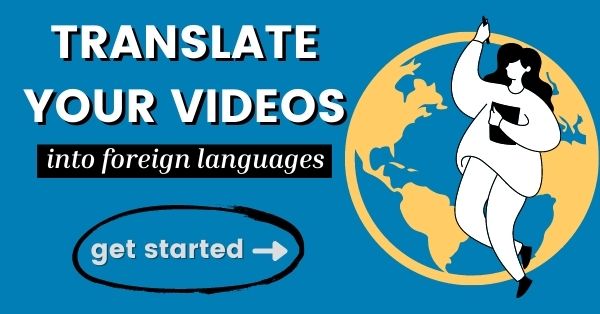Video Translation in a Hybrid World
Updated: August 30, 2023
After an unprecedented global pandemic that led to relying solely on digital communications, many people are slowly making their way back to in-person settings.
Even as physical gatherings become more commonplace, however, we’re seeing many virtual components stick around in the form of hybrid events. Hybrid events are those that combine both in-person and virtual components. Many industries are seeing the benefits of a virtual world, including the ability to meet accessibility needs and reach global audiences. Remote opportunities have proven to have several benefits that will likely continue beyond the pandemic while reintroducing in-person.
With the right support and resources, many organizations have been able to successfully shift to a hybrid world and have even found benefits of combining virtual with in-person.
One key component of a hybrid environment is the use of video. Whether it’s live or pre-recorded, online video content is a powerful tool for engaging audiences.
When preparing for a hybrid meeting or event, you want to ensure that your videos are made accessible using video translation and subtitling. As our world becomes more globalized and reliant on digital technologies, catering to a diverse audience is more important than ever.
Learn More About 3Play’s Translation and Subtitling Service ➡️
The Hybrid Approach
Communication is no easy feat. Now couple that with half of an audience in-person and the other half remote – it’s even harder.
For many, the hybrid model was more of a necessity than a choice. CXApp found that 70% of event professionals moved their in-person events to a virtual platform.
Although organizations had to pivot quickly, the good news is that there are ways to ensure a cohesive and collaborative hybrid experience. Plus, there are plenty of examples out there showcasing how organizations are tackling this new approach.
In particular, educational institutions have been able to seamlessly implement hybrid learning models for their students. While some students prefer to learn in-person with physical access to a professor and learning materials, others prefer to do everything online.
These institutions can show us a great deal about the best hybrid strategies.
First and foremost, hybrid environments are incredibly beneficial from an accessibility perspective.
Approximately one billion people in the world, or 15% of the global population, have some form of disability. In a hybrid world, people with disabilities can choose which environment suits their needs best and receive tailored accommodations. For example, a deaf or hard of hearing person might want to participate in a meeting or event virtually. They can watch the video in real-time or afterward and still have access to captions without the need for an interpreter.
Oppositely, that same deaf or hard of hearing person can attend in-person and have access to an ASL interpreter. There’s flexibility with both options; it’s just a matter of preference.
A hybrid model also offers accessibility for foreign language speakers. They may not have to rely on captions, but subtitles can open doors for these learners.
There are over 7,000 languages spoken globally, and with the growing popularity of video, many people want to watch remotely.
When in-person, it can be challenging and expensive to have multiple interpreters for different languages. However, when remote, viewers have the ability to choose their preferred language with subtitles.
Subtitling and video translation is a more simple and cost-effective route because it gives organizations an easy way to have their video content translated into multiple languages without breaking the bank.
Given that technology has bridged the gap between cultures, video translation is more important than ever before. On YouTube alone, one of the largest video search engines in the world, 80% of its views come from outside of the United States.
Our world is moving rapidly, and to keep up with the pace, you’ll want to be proactive about your approach to the new hybrid world. Keeping accessibility, through tools like captioning and video translation, at the forefront will only help your organization stay ahead of the curve.
Translate Your Hybrid Video Content➡️
Best Practices for a Hybrid World
The hybrid model is new for many organizations. However, with the following tips in place, you’ll be more prepared for successful in-person and virtual environments.
Best Practices for a Hybrid World
- Understand your tech
- Have a centralized online location
- Caption your content
Understand Your Tech
Arguably the most important factor of a seamless hybrid environment is the technology.
80% of Americans experience some type of tech issue every day.
Frustrated viewers mean fewer people who will be willing to engage with your video content.
One of the many perks of being in-person is that you don’t have to worry so much about tech. However, for those who are tuning in remotely, it could make or break the experience.
Our advice is to make sure you understand the technology you’re using, including the video platform, sound equipment, lighting, subtitling service, and so much more.
Also, be sure to test your tech well before your event or meeting to alleviate any problems that may arise.
Have a Centralized Online Location
Another important consideration for a hybrid environment is to have one centralized location for viewers to access your video content online.
It can become overwhelming for viewers if there are multiple locations or no clear place to find your videos.
We encourage you to make it clear to both in-person and online viewers where they can find your information. This is great for those who are tuning in live and those who want to watch the replay after the event or meeting.
A centralized online location could be a website, a YouTube channel, a social media account, etc.
Tip: ensure that foreign language viewers can access subtitles from your centralized location as well!
Caption and Translate Your Content
Last but not least, if you’re translating content into other languages, you’ll want to caption it first. This makes the video translation process much easier!
Subtitling is the process of translating the original audio within a video into another language. Just like captions, they are a textual representation of the audio.
With captions, half of the video translation process is done because you already have the text. Once your content has been captioned, the next step would be to translate it into your desired language(s).
We recommend that you work with a captioning and video translation vendor to save you time, money, and additional resources – especially if you have a large amount of video content.
3Play Media’s Video Translation Service
At 3Play Media, we offer a robust video translation and subtitling service that gives our customers peace of mind.
We integrate with over 20 major video players and platforms, seamlessly translating your content with little to no work on your end. That way, you can use your resources to ensure you’re providing the best hybrid experience possible.
With over 40 languages to choose from, you can ensure that your video content is accessible to a broader audience – no matter their language preference.
If you’re familiar with our captioning and transcription process, you know we value accuracy at 3Play. Our translations are done by professional linguists who make sure your video content is translated accurately and maintain the same cultural context as the original language.
Additionally, we pride ourselves on being a video accessibility partner. Whether it be translations, captioning, or audio description – we’ve got you covered.
Looking to partner with a video translation vendor that can enhance your hybrid environment? 3Play Media is here to help. Discover why more than 5,000 companies put their trust in us every year!
Further Reading

Subscribe to the Blog Digest
Sign up to receive our blog digest and other information on this topic. You can unsubscribe anytime.
By subscribing you agree to our privacy policy.











